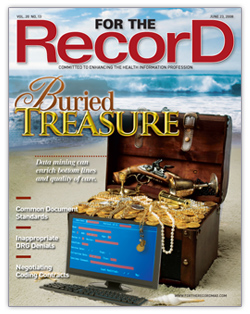 June 23, 2008
June 23, 2008
Coding for Schizophrenia
For The Record
Vol. 20 No. 13 P. 31
Schizophrenia (ICD-9-CM category 295) is a serious mental disorder characterized by a loss of contact with reality (psychosis), hallucinations (false perceptions), delusions (false beliefs), abnormal thinking, flattened affect (restricted range of emotions), diminished motivation, and disturbed work and social functioning. Typically, these chronic disorders affect patients in late adolescence or early adulthood and require lifelong treatment.
Signs and Symptoms
The general symptoms of schizophrenia include beliefs not based on reality (delusions), seeing or hearing things that don’t exist, lack of emotions, emotions inappropriate to a situation, angry outbursts, catatonic behavior, paranoia, difficulty functioning at work, and incoherent speech.
The symptoms may be further categorized as negative or positive. Negative symptoms of schizophrenia include loss of interest in everyday activities, appearing to lack emotion, a reduced ability to plan or carry out activities, neglecting hygiene, social withdrawal, and loss of motivation.
Positive symptoms of schizophrenia are unusual thoughts that involve a loss of contact with reality and can include hallucinations, delusions, thought disorders, difficulty speaking, disorganized thoughts, involuntary movements, and clumsiness.
Types
The following are the main types of schizophrenia:
• Paranoid schizophrenia (295.3x) is characterized by preoccupation with delusions or auditory hallucinations without prominent disorganized speech or inappropriate affect.
• Disorganized schizophrenia (295.1x) is characterized by disorganized speech, disorganized behavior, and flat or inappropriate affect.
• Catatonic schizophrenia (295.2x) has predominate physical symptoms, including either immobility or excessive motor activity and the assumption of bizarre postures.
• Undifferentiated schizophrenia (295.9x) has psychotic symptoms but does not meet the criteria for paranoid, disorganized, or catatonic types.
• Residual schizophrenia (295.6x) has the presence of positive symptoms but at a low intensity.
• Simple schizophrenia (295.0x) is the progressive development of prominent negative symptoms but with no history of psychotic episodes.
• Schizoaffective disorder (295.7x) is a psychotic disorder characterized by significant mood symptoms (depression or mania) and schizophrenia symptoms. The diagnosis requires that mood symptoms be present for a substantial portion of the illness’ total duration. Differentiating schizoaffective disorder from schizophrenia and affective disorder may require a longitudinal assessment of symptoms and symptom progression. The prognosis is somewhat better than that for schizophrenia but worse than that for mood disorders.
Fifth Digit Subclassification
A fifth digit subclassification is required for category 295 as follows:
• 0 — Unspecified;
• 1 — Subchronic;
• 2 — Chronic;
• 3 — Subchronic with acute exacerbation;
• 4 — Chronic with acute exacerbation; or
• 5 — In remission.
Diagnosis
The diagnostic criteria, as specified by the Diagnostic and Statistical Manual of Mental Disorders, include the following:
• presence of at least two of the following: delusions, hallucinations, disorganized speech, disorganized or catatonic behavior, or presence of negative symptoms;
• significant impairment in the ability to work, attend school, or perform normal daily tasks;
• presence of signs and symptoms for at least six months; or
• other potential mental health disorders have been ruled out.
Treatment
Antipsychotic medications are the most commonly prescribed medications to treat schizophrenia. The following are the common ones used in treatment: risperidone (Risperdal), olanzapine (Zyprexa), haloperidol (Haldol), thioridazine, fluphenazine, clozapine (Clozaril), quetiapine (Seroquel), ziprasidone (Geodon); aripiprazole (Abilify), and paliperidone (Invega).
Coding and sequencing for schizophrenia are dependent on the physician documentation in the medical record and application of the Official Coding Guidelines for inpatient care. Also, use specific AHA Coding Clinic for ICD-9-CM and American Medical Association CPT Assistant references to ensure complete and accurate coding.
— This information was prepared by Audrey Howard, RHIA, of 3M Consulting Services. 3M Consulting Services is a business of 3M Health Information Systems, a supplier of coding and classification systems to nearly 5,000 healthcare providers. The company and its representatives do not assume any responsibility for reimbursement decisions or claims denials made by providers or payers as the result of the misuse of this coding information. More information about 3M Health Information Systems is available at www.3mhis.com or by calling 800-367-2447.



